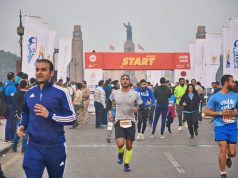 We can dance through our teens, jog through our twenties and thirties, stride confidently through our forties and fifties. But then, ever so gradually, many of us will start to detect a new stiffness when kicking ourselves out of bed in the morning, a lack of spring in our step, and aches and pains that hadn’t existed before. What used to be a kiss goodbye to an active lifestyle, or a need for complicated hip or knee replacement surgery with lengthy recuperation has now been changed, thanks to pioneering techniques, innovative materials and new technology. Leading orthopaedic surgeon Prof. Dr. Ali Ghoz banished a lot of our pre-conceived notions and fears about aging and bone health in a recent chat.
We can dance through our teens, jog through our twenties and thirties, stride confidently through our forties and fifties. But then, ever so gradually, many of us will start to detect a new stiffness when kicking ourselves out of bed in the morning, a lack of spring in our step, and aches and pains that hadn’t existed before. What used to be a kiss goodbye to an active lifestyle, or a need for complicated hip or knee replacement surgery with lengthy recuperation has now been changed, thanks to pioneering techniques, innovative materials and new technology. Leading orthopaedic surgeon Prof. Dr. Ali Ghoz banished a lot of our pre-conceived notions and fears about aging and bone health in a recent chat.
CWM: Professor Ghoz, what steps have taken place in recent years in the field of orthopaedic surgery?
AG: There have been developments on several fronts, with many related to the use of more durable joint replacements that can last longer, such as plastic polyethylene for hip and knee replacements, along with more natural ceramic materials. Hip and knee replacements can now last for 15 to 25 years.
There have also been major advances in the use of robotic surgery and computer-guided surgery, with specific instrumentation. An important step is related to cellular studies, regarding progression and the use of platelet-rich plasma as stem cells, which will be the future in 10 to 20 years time in the orthopaedic field.
A ground- breaking advance has been the anterior approach hip replacement, a technique recently carried out by a select number of surgeons, including myself. This is minimally invasive, with a lower risk of dislocation, less bleeding and a shorter recovery period. Most patients who undergo this procedure usually recover in less than 6 weeks, often within 3 to 4 weeks, opposed to conventional hip replacement surgery which can involve at least 3 months’ rehabilitation to get back to normal, along with certain restrictions and precautions.
Recent advances have allowed us to see much reduced recovery times, although of course, it can vary from patient to patient.
Are most cases you see a result of age and bone degeneration or as a result of accident and injury?
We see a cross-section of cases, covering an aging generation with problems that lead to arthritis, along with injuries caused by accidents and trauma. There is common ground between the two, as trauma can lead to arthritis later in life. Many patients fall within the 65 to 67 year range, however the number of patients suffering from early onset arthritis is increasing, especially that affecting the knees and hips. It can be an advanced condition that requires remedial surgery, even at a relatively early age. Of course, there are also trauma and fracture cases that require immediate fixation and stabilization using plates and computer-guided surgery.
What consultations and steps are usually undertaken to determine the best course of treatment for an orthopaedic procedure?
First, there should be an initial consultation, listening to the patient and analyzing the complaint while treating the patient as a whole. This is followed up by a thorough clinical examination, assessing the problem and the carrying out of necessary tests and imaging. This covers X-rays and more advanced imaging like MRI. This has evolved to 3T and 1.5 T, which provide magnificent images of the whole body in addition to 3D construction, CT reconstruction and 3DCT reconstruction, not only for anatomy and fractures, but also for severely arthritic joints.
After these investigations and history-taking examination we put an individualized treatment plan in place. This also has to take the patient’s expectations into account. It involves significant pre-operative planning, correct selection and sizing of the implants as well as an advanced type of X-ray to provide a more accurate positioning of the implants. The long-term treatment plan involves follow up for at least a year after any procedure to ensure that the patient has a good outcome. We also measure this on a database to use to assess mobility levels pre and post surgery and treatment.
What is new in knee replacement surgery?
In addition to the new computer-guided techniques and durable replacement materials we now implement a minimally invasive approach to reduce trauma to the knee. This leads to a potentially shorter rehabilitation period, less pain, fewer possible complications and speedier recovery. Our work as orthopaedic surgeons also encompasses soft tissue knee surgery and reconstruction using keyhole orthoroscopic surgery, which is minimally invasive and allows for a shorter rehabilitation period.
Are there factors that can impact the successful outcome of surgery, such as weight management and correct rehabilitation?
Of course, and the most important of these has to be weight management. Patients with a lower BMI have a decreased risk of complications, a lower risk of infection, less risk of bleeding and deep vein thrombosis. Technically they will do better than a patient with a high BMI. It is also vital to maintain mobility both before and after surgery to avoid stiffness in the joints and to lower the risk of deep vein thrombosis. The treatment plan is not limited to surgery; it must be followed at all stages. Rehabilitation ideally should include physiotherapy and positive motivation for the patient to exercise and stay active.
The surgery itself is a key factor. It is important to select a surgeon who is an expert in the field, a person who has carried out quite a lot of similar operations. This will help to ensure accurate placement of components, fixation and soft tissue reconstruction, as well as correct handling of soft tissue and asepsis to avoid post-operative infection. In choosing an implant, your surgeon must ensure that it is one of the 10A Star rated implants for joint replacement, and a recognised device for reconstruction of ligament or cartilage.
What advice would you offer to people in terms of maintaining good bone health?
It is essential to stay at a healthy weight and BMI, to follow a healthy lifestyle and diet, along with a level of activity suited to your age. As we pass middle age we should move to less strenuous forms of exercise such as swimming and cycling. Visits to the gym for aerobic exercise are important, too. Correct footwear is also important as this will aid walking and gentle exercise, which allows bone homeostasis and regeneration. Don’t forget the importance of sunlight and Vitamin D intake, a big factor in maintaining bone health.
Although you are primarily London-based, are you also available for consultations in Cairo?
Certainly, I provide an advice service at my local clinic for patients considering surgery, whether locally or abroad. In some cases patients may be unable to travel, or may simply prefer to have surgery where they have family support at hand. Either way, they are looking for an experienced, expert opinion from a surgeon who has up-to-the minute knowledge of the latest advances in the field. I travel regularly to Egypt and it is an important part of my work to offer that.
Bio:
Prof. Dr. Ali Ghoz is one of only a few U.K. Trauma and Orthopaedic surgeons specialising in minimally invasive custom-made bespoke hip and knee surgery with an emphasis on computer guided surgery and precision surgery. For more information, visit our Address Book.
Contact info:
Professor Ali Ghoz
Website: www.professoralighoz.co.uk
Tel: +44 7858 327872





